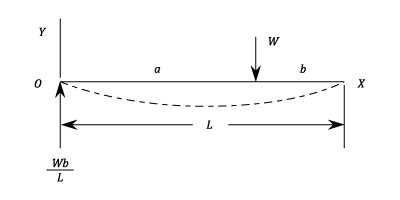Macaulay Method
Describes the Macaulay Method for calculating the deflection of Beams.
Contents
Macaulay's Method - Introduction
DefinitionMacaulay's method (The double integration method) is a technique used in structural analysis to determine the deflection of Euler-Bernoulli beams. Use of Macaulay's technique is very convenient for cases of discontinuous and/or discrete loading.
Using Calculus to find expressions for the deflection of loaded beams (See Deflection of Beams Part 1), it is normally necessary to have a separate expression for the Bending Moment for each section of the beam between adjacent concentrated loads or reactions. Each section will produce its own equation with its own constants of integration. It will be appreciated that in all but the simplest cases the work involved will be laborious; the separate equations being linked together by equating slopes and deflections given by the expressions on either side of each "junction point".
However, a method devised by Macaulay enables one continuous expression for bending moment to be obtained, and provided that certain rules are followed the constants of integration will be the same for all sections of the beam.
It is advisable to deal with each different type of load separately.Concentrated Loads
A beam is a horizontal structural element that is capable of withstanding load primarily by resisting bending. The bending force induced into the material of the beam as a result of the external loads, own weight, span and external reactions to these loads is called a bending moment.
Measuring  from one end write down an expression for the Bending Moment in the last section of the beam enclosing all less than
from one end write down an expression for the Bending Moment in the last section of the beam enclosing all less than  in square brackets, i.e.
in square brackets, i.e.
![E\,I\,\frac{d^2y}{dx^2} = M = -\,W_1x + R[x - a] - W_2[x - b] - W_3[x - c]](https://latex.codecogs.com/svg.image?E\,I\,\frac{d^2y}{dx^2}&space;=&space;M&space;=&space;-\,W_1x&space;+&space;R[x&space;-&space;a]&space;-&space;W_2[x&space;-&space;b]&space;-&space;W_3[x&space;-&space;c]) Subject to the condition that all terms for which the quantities in the square brackets are negative are omitted ( i.e. given a value of zero), this equation may be said to represent the bending moment for all values of
Subject to the condition that all terms for which the quantities in the square brackets are negative are omitted ( i.e. given a value of zero), this equation may be said to represent the bending moment for all values of  . If
. If  is less than
is less than  then both the last two terms are omitted and so on.
then both the last two terms are omitted and so on.
MISSING IMAGE!
23287/Macaulay-01.png cannot be found in /users/23287/Macaulay-01.png. Please contact the submission author.
The brackets are integrated as a whole, i.e.
![E\,I\,\frac{dy}{dx} = -\,W_1\frac{x^2}{2} + \frac{R}{2}[x - a]^2 - \frac{W_2}{2}[x - b]^2 - \frac{W_3}{2}[x - c]^2 + A](https://latex.codecogs.com/svg.image?E\,I\,\frac{dy}{dx}&space;=&space;-\,W_1\frac{x^2}{2}&space;+&space;\frac{R}{2}[x&space;-&space;a]^2&space;-&space;\frac{W_2}{2}[x&space;-&space;b]^2&space;-&space;\frac{W_3}{2}[x&space;-&space;c]^2&space;+&space;A) And,
And,
![E\,I\,y = -\,W_1\frac{x^3}{6} + \frac{R}{6}[x - a]^3 - \frac{W_2}{6}[x - b]^3 - \frac{W_3}{6}[x - c]^3\;+Ax + B](https://latex.codecogs.com/svg.image?E\,I\,y&space;=&space;-\,W_1\frac{x^3}{6}&space;+&space;\frac{R}{6}[x&space;-&space;a]^3&space;-&space;\frac{W_2}{6}[x&space;-&space;b]^3&space;-&space;\frac{W_3}{6}[x&space;-&space;c]^3\;+Ax&space;+&space;B) By doing so it can be shown that the constants of integration are common to all sections of the beam, e.g. if
By doing so it can be shown that the constants of integration are common to all sections of the beam, e.g. if 
(b&space;-&space;\Delta&space;)^2&space;+&space;\left(\frac{R}{2}&space;\right)(b&space;-&space;\Delta&space;&space;-&space;a)^2&space;+&space;A) And,
And,
(b&space;-&space;\Delta&space;)^3&space;+&space;\left(\frac{R}{6}&space;\right)(b&space;-&space;\Delta&space;&space;-&space;a)^3&space;+&space;A(b&space;-&space;\Delta&space;)&space;+&space;B)
(b&space;+&space;\Delta&space;)^2&space;+&space;\left(\frac{R}{2}&space;\right)(b&space;+&space;\Delta&space;&space;-&space;a)^2\;-\left(\frac{W_2}{2}&space;\right)\Delta&space;^2+\;A') And,
And,
(b&space;-&space;\Delta&space;)^3&space;+&space;\left(\frac{R}{6}&space;\right)(b&space;+&space;\Delta&space;&space;-&space;a)^3\;-\left(\frac{W_2}{6}&space;\right)\Delta&space;^3+\;A'(b&space;+&space;\Delta&space;)&space;+&space;B') Now as
Now as  the slope and deflection values must correspond (i.e.) at
the slope and deflection values must correspond (i.e.) at  from which it can be seen that
from which it can be seen that  ' and
' and  '. The values of
'. The values of  and
and  are found as before ( Part 1).
are found as before ( Part 1).
Uniformly Distributed Loads.
Supposing that a uniformly distributed load is applied from a distanceMISSING IMAGE!
23287/Macaulay-02.png cannot be found in /users/23287/Macaulay-02.png. Please contact the submission author.
Concentrated Bending Moment
MISSING IMAGE!
23287/Macaulay-06.png cannot be found in /users/23287/Macaulay-06.png. Please contact the submission author.
Example:
[imperial]
Example - Example 1
Problem
A simply supported beam of length  carries a load
carries a load  at a distance
at a distance  from one end and
from one end and  from the one
from the one ) .
Find the position and magnitude of the maximum deflection and show that the position is always approximately within
.
Find the position and magnitude of the maximum deflection and show that the position is always approximately within  of the centre.
of the centre.
Workings

Solution
- The distance from the centre of the beam is
 Login
Login

